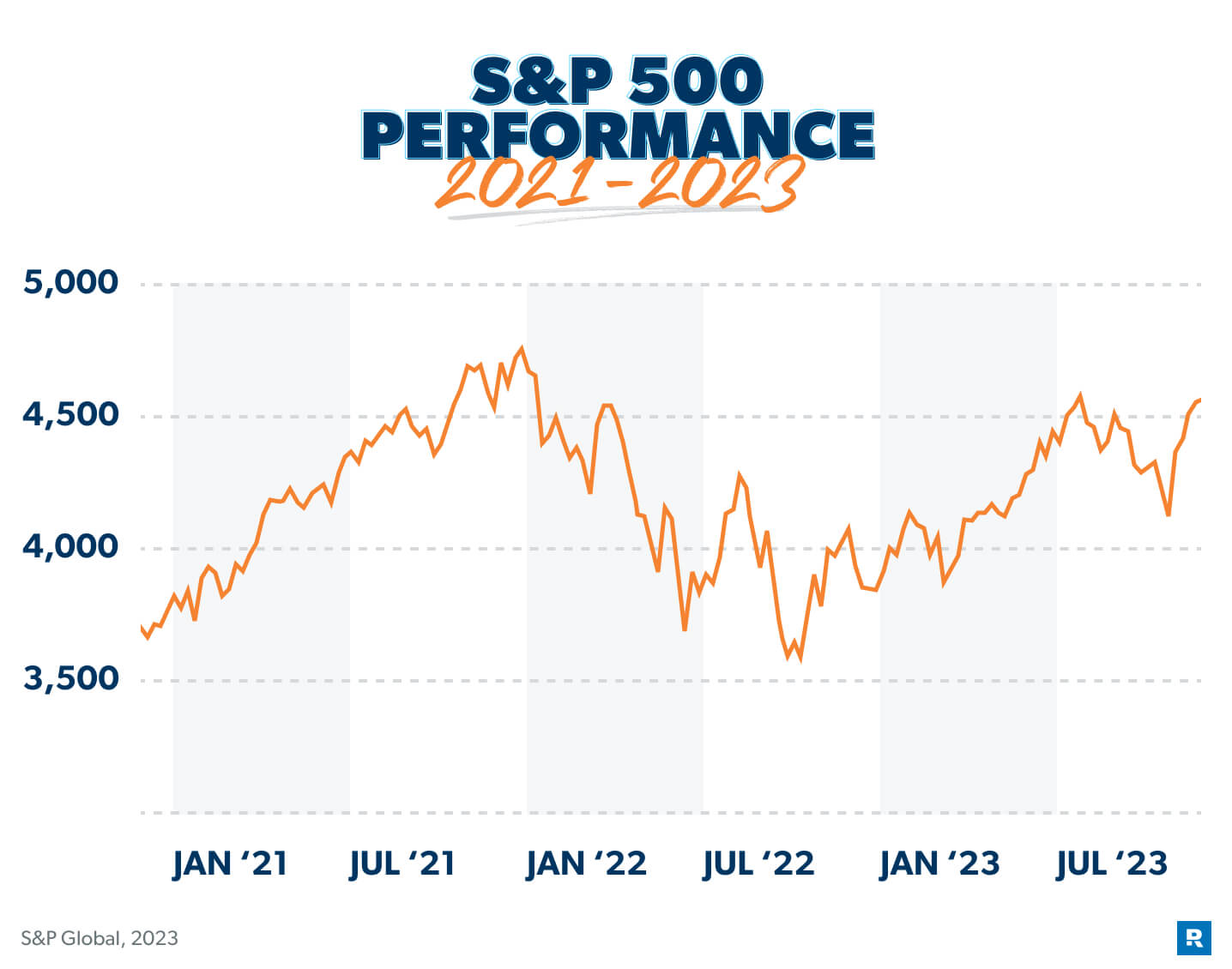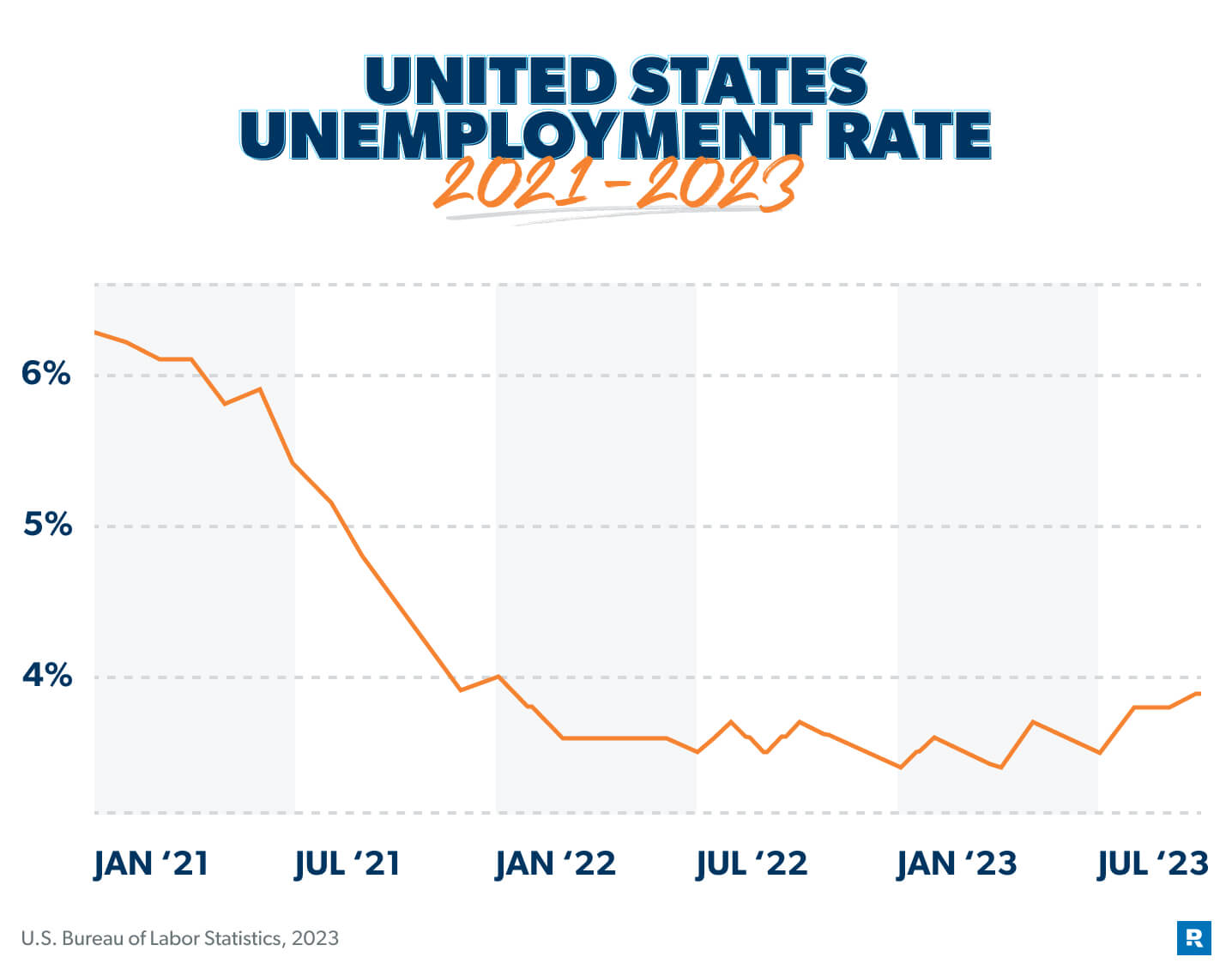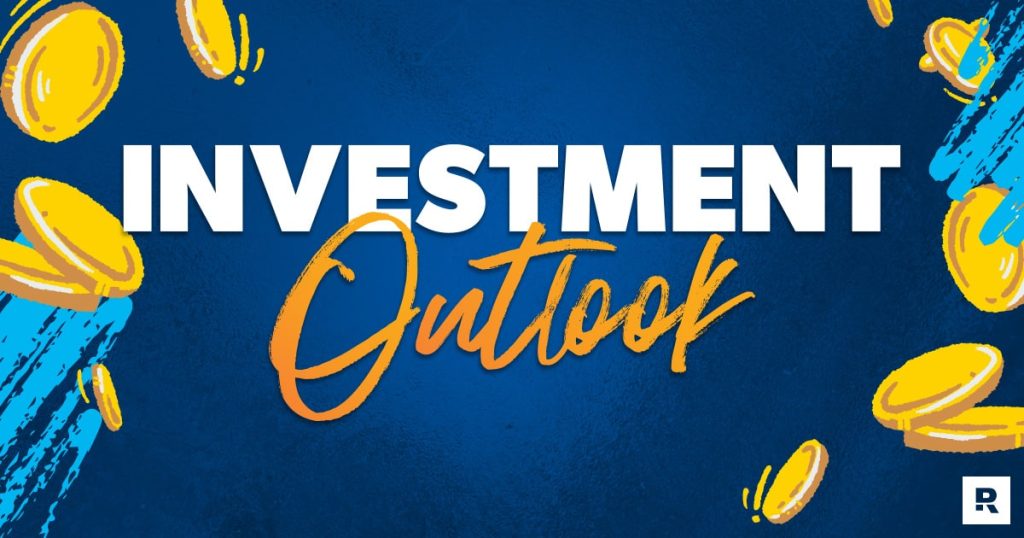As we kick off the new year, how are you feeling about your own financial situation and the economy as a whole? Are you scared about a possible recession looming around the corner? Worried about inflation? Afraid to take a quick peek at your 401(k) balance?
If that’s you, you’ve got plenty of company.
According to The State of Personal Finance report from Q2 of 2023, the vast majority of Americans (75%) are worried about the direction the economy is headed and almost half (49%) said their financial situation has had a negative effect on their mental health. Meanwhile, a lot of folks have fallen deeper into debt since the summer and 33% of Americans have no savings at all. America, we have a problem!
You can’t control what happens to the economy. But if you’re investing to build wealth and save for retirement, you can get the information you need to help you make empowered decisions and keep a level head—no matter what’s happening on Wall Street.
How Much Can You Save for Retirement in 2024?
According to The National Study of Millionaires, the path to becoming a millionaire runs through your 401(k)! That’s where 8 in 10 millionaires built their wealth. And thanks to adjustments for inflation, you’ll be able to save a little more in your workplace retirement accounts this year.
- The IRS is raising the annual contribution limits for employer-sponsored retirement plans to $23,000 (up from $22,500 in 2023). This includes folks who contribute to a 401(k), a 403(b), most 457 plans, and the federal government’s Thrift Savings Plan.1
- For those who are nearing retirement and need to catch up, you can also put an extra $7,500 into your plan if you’re age 50 and older.2
What about the annual limit for IRAs? You can save up to $7,000 in your IRA accounts in 2024—and that goes for Roth and traditional IRAs. If you’re age 50 or older, the catch-up contribution will also remain at $1,000, so you can put up to $8,000 into an IRA in 2024 if you’ve fallen behind on your retirement savings.3
One last thing before we move on: You’ll be able to save just a little bit more in your Health Savings Account (HSA) if you have one. For 2024, individuals can save up to $4,150 (that’s a $300 increase), while families can put $8,300 (a $550 increase from last year) into their HSAs.4 It’s a nice bump, so take advantage if you can!
What Are Economic Indicators?
Economic indicators are just some statistics and trends that give us insight into how the economy is doing and where it might be headed. That’s the short and sweet of it. Think of these economic indicators as thermometers that help us keep an eye on the temperature of the overall economy.
Here are six of the major economic indicators to keep an eye on in 2024:
- Stock Market
- Housing Market
- Interest Rates and Inflation
- Unemployment Rate
- Consumer Confidence
- Gross Domestic Product
Let’s take a look at these indicators and find out what they could mean for you and your money.
1. Stock Market
The stock market is kind of like your local supermarket—the biggest difference is that instead of buying bread and milk, you’re buying and selling stocks, which are basically small pieces of ownership in a company.
The S&P 500 index, which measures the performance of 500 of the largest companies whose stocks trade on the New York Stock Exchange and Nasdaq, is considered the most accurate measure of the stock market as a whole. When this index increases, the economy is usually doing well. Still with us?
Market chaos, inflation, your future—work with a pro to navigate this stuff.
You know we’re always telling people that the stock market is like a roller coaster—full of ups and downs that can make your head spin. Well, after the stock market climbed to new heights during 2021, the ride took a downward turn in 2022. The market began a slow march back up in 2023—erasing most of 2022’s losses—but it’s still not back to its January 2022 high.
Let’s take a quick look back at what happened—and what we can expect moving forward.

The Federal Reserve’s attempts to combat inflation with aggressive interest rate hikes caused some big swings in the market. But the S&P 500 still had a strong year and is expected to finish 2023 up about 17%!5 That’s well above average.
Will the stock market continue its upward trend? Maybe, but it probably won’t be a double-digit percentage increase in 2024. Many analysts expect the S&P to have below-average growth of around 6% in 2024. On the other hand, the 2024 market outlook for a few analysts is 12% growth.6
But you just have to take market predictions with a grain of salt because even experts get predictions wrong. At the start of 2023, many predicted little to no S&P growth in 2023.7 And we ended up with almost 20% growth!
Remember: Investing is a marathon, not a sprint. No matter what the stock market is doing, stay focused on the long term, avoid making decisions out of fear, and keep saving for retirement (as long as you’re out of debt and have an emergency fund in place).
Political parties and presidents may rise and fall, but the stock market has a long history of moving upward. The historical average annual rate of return for the stock market according to the S&P 500 is 10–12%.8 So stay focused and keep putting money in your 401(k) and your Roth IRA—and do not cash them out “just in case.”
2. Housing Market
So, now that we’ve taken a look at what’s happening with the stock market, what’s in store for the housing market? It’s been pretty crazy in 2023, with rising interest rates and low inventory making buying a home pretty difficult. But what’s really happening in the world of real estate?
Here are a few trends you should be aware of as we move into a new year:
Home inventory is still low, but starting to rise.
The real estate market has been dealing with low inventory for several years now, which means there aren’t enough homes for sale to meet buyer demand.
But the tide may be turning in favor of buyers in 2024. The number of newly listed homes grew annually in November for the first time in 17 months.9 This could be a sign that homeowners are becoming more willing to sell their homes—even though they’ll have to buy another home with a higher interest rate. But it’s still too early to know if this trend will continue in 2024.
Still, the housing supply is incredibly low. The number of active home listings in October 2023 was about 39% lower than it was before the coronavirus pandemic began.10 So, if you’re planning to buy a home this year, you’ll still have to be pretty quick on the draw!
Home prices are still going up, but at a slower rate.
Home prices were pretty much flat in 2023. The national median home price for active listings was $425,000 in October 2023—which is exactly what it was in October 2022.11 For 2024, the National Association of Realtors predicts less than a 1% increase in prices.
Since there’s still strong buyer demand and a shortage of homes for sale, prices aren’t going to drop—but they aren’t going to jump either.
Mortgage rates will likely stay high for now.
The days of mortgage interest rates below 3% are long gone. Since the Federal Reserve started raising interest rates in 2022 (more on what might be coming later), the average rate for a 15-year fixed-rate mortgage has jumped to 6.56%. The average rate for a 30-year fixed-rate mortgage (as of November) was 7.22%—and at one point in 2023, it nearly hit 8%. Mortgage rates are higher than they’ve been in 20 years!13
The good news is that the Mortgage Bankers Association expects rates to fall to 6.1% by the end of 2024.13
So whether you’re buying a home or selling one in 2024, it might be time to reset your expectations. For sellers, the rise in interest rates has cooled demand . . . which means it might take a little longer to sell your house.
What if you’re planning to buy? Our advice is simple: Be patient. If you have to take out a mortgage, a 15-year mortgage is the only way to go. That’s because it’ll save you tens of thousands of dollars in interest over the course of repaying your loan.
Whether you’re buying or selling a home, get in touch with one of our RamseyTrusted real estate pros. They know your housing market like the back of their hand and can help you buy or sell your home—even in an unpredictable housing market!
3. Interest Rates and Inflation
Okay, hang with us here. The Federal Reserve (aka the Fed) is the U.S. central bank in charge of the nation’s policies on money. The Fed has two main goals: grow the economy at a sustainable rate and keep inflation under control.
The Fed has several ways to achieve its goals, but one of its main tools is raising and lowering interest rates. Now, the Fed doesn’t tell commercial banks what interest rates to charge on loans, but they do influence the banks’ rates by setting the federal funds rate. The federal funds rate is the interest rate banks charge to each other for overnight loans, and it influences most other interest rates.
Lowering interest rates can give the economy a boost because it makes people and businesses more likely to borrow and spend money. But if too many dollars are chasing too few goods, prices rise—and that’s called inflation.
Raising interest rates can slow inflation down because it encourages people to spend less and save more. But if rates are too high, they can choke economic growth. When interest rates are high, businesses tend to spend less, and this can also lead to higher unemployment. So, the Fed tries to find a balance that’s just right.
With inflation hitting a 40-year high in 2022—impacting everything from how much we spend for a gallon of gas to the cost of a dozen eggs—the Fed repeatedly raised interest rates throughout 2022 to try to cool things down. It continued raising rates in the first half of 2023 until the benchmark interest rate hit 5.33%, the highest level in over 20 years.14
Inflation has dropped to 3.2% (from a high of 9.1% in June 2022), but it still remains above the Fed’s 2% target rate.15 The Fed stopped raising rates in July because inflation seems to be headed in the right direction, and many analysts think the Fed will start cutting rates in the spring of 2024.16 Inflation is expected to be around 2.5% by the end of 2024.17
Lower inflation could give some relief to Americans struggling to pay their bills. According to a study done by Ramsey Solutions, one-third of Americans said they are struggling or in crisis financially, and over half of Americans are having difficulty paying their bills. If that’s you, here are some smart ways to deal with it:
- Adjust your budget. This means you might have to cut back on some things in order to pay for necessities. Look for ways to save money by using coupons, buying generic brands, or carpooling.
- Look for ways to boost your income. A side hustle is a great way to earn extra income for bills or your debt snowball. If you’re stuck in a dead-end job, face your fear of the unknown and start looking for a new job!
- Keep investing for retirement. The best way to protect your nest egg from rising prices is to grow your money at a higher rate than inflation with good growth stock mutual funds.
No matter how high or how low interest rates are, borrowing money for things like a car loan or a home equity loan is always a bad idea. We want interest to work for you, not against you. Debt isn’t your friend. It takes your time and money, and it gives you headaches and heartaches in return.
4. Unemployment Rate
This next one is easy. Each month, the unemployment rate tells us how many people got (or lost) a job. It’s one of the clearest ways to see which way the economy is moving. Rising unemployment is scary—that means fewer people are working, which weakens the economy. Lower unemployment means more people are finding work and the economy is getting stronger . . . which is what we all want.
The unemployment rate at the beginning of 2023 was around 3.4%, which showed that the job market had pretty much recovered from the pandemic (before the pandemic, the unemployment rate was 3.5%).18

Unemployment has gone up some in 2023, and hit 3.9% in October.19 The red-hot job market has cooled, but unemployment is still low.
With the economy expected to slow down more in 2024 in response to the Federal Reserve’s interest rate hikes, some analysts expect unemployment to rise in the new year. But even with that pessimistic outlook, the unemployment rate is only projected to rise to around 4.2% in 2024, which is still fairly low.20
So, what does all that mean for your investments? Well, as job growth slows down, that means less growth for companies . . . which could hurt your investments in the short term. But don’t panic—this kind of thing happens from time to time. Work with your financial advisor to see if you need to make any adjustments to your portfolio or if you should just ride it out for the long haul.
5. Consumer Confidence
You can usually tell when someone feels confident. They walk with their head held high, and they have a swagger in their step. They also tend to spend more and save less! Well, that last part is what the Consumer Confidence Index says, at least.
The Consumer Confidence Index is a survey done by an organization called The Conference Board. The index measures how everyday Americans feel about the economy. When people are confident, they typically spend more money. When their confidence is low, they don’t.
High interest rates and prices in 2023 —plus anxiety over war and conflicts and a possible recession on the horizon—have put a damper on consumer confidence that’s expected to continue in 2024. About two-thirds of consumers say a recession is likely in 2024.21
In the face of rising prices, many Americans are turning to credit cards, buy now, pay later plans, or dipping into their savings accounts to keep up their spending. In fact, Americans have accumulated more than $1 trillion in credit card debt.22
With more Americans going back into debt and savings rates slipping to their lowest level in nearly two decades, millions of families could be in trouble down the road. That’s why it’s more important than ever to get on a budget, stay away from debt, and keep saving and investing for the future to outpace inflation.
6. Gross Domestic Product
In a nutshell, gross domestic product (GDP) is the value of all goods and services produced in a country during a specific time period. The GDP of the United States is a huge number: about $25 trillion a year!23 GDP growth is a key measure of the health of a country’s economy.
When GDP growth is negative for two consecutive quarters, that usually means a country is experiencing a recession. GDP growth was positive in the first three quarters of 2023, and it is expected to finish 2023 in positive territory.24
The Federal Reserve of St. Louis predicts GDP growth will slow in 2024 but stay positive and end the year at 1.3%. If that’s the case, the Fed will have achieved its so-called “soft landing”—lowering inflation without pushing the economy into a recession.25
Here’s the Bottom Line
The key to building wealth is consistency. That’s the thread that ties millionaires together.
No matter what’s going on in the world, millionaires keep working hard and putting money away. They don’t get distracted. They don’t put their hard-earned money in a flashy investing trend they don’t fully understand. They don’t panic every time the stock market has a bad day.
And one day, they look up and see their nest egg has hit the seven-figure mark. Now that’s what winning looks like. And there’s no reason that can’t be you someday.
Need More Investment Advice? Find a Pro!
While some of the current trends can be concerning (inflation, rising interest rates), it’s not all bad news (strong job market, stable housing market). But we’re guessing you probably have more questions about your own situation.
While we can’t speak to the specifics of your financial plan, the good news is, you can sit down with an investment professional in your area who can.
Find a SmartVestor Pro now!
Read the full article here














